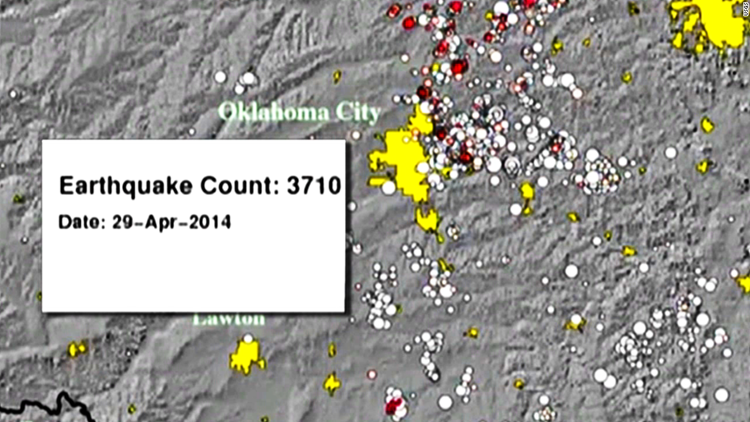(CNN) — On Saturday and Sunday in Oklahoma, there were seven earthquakes. You read that right. Not tornadoes. Earthquakes.
The most severe temblor registered 4.3 near Langston, the U.S. Geological Survey site showed, delivering a rumble to Logan County, north of Oklahoma City, according to the U.S. Geological Survey. There were no reports of damage or major injury on Saturday, Oklahoma City news station News9 reported.
The three earthquakes that happened Sunday occurred near Langston, CNN affiliate KOCO reported, one registering 4.0.
The station is covering Sunday’s temblors as a developing story.
Damage and injury are far more likely with quakes that register 4.0 and higher, the USGS reports.
The temblors seem to be part of a trend in the state. As of last month, Oklahoma had surpassed California in the number of earthquakes.
From 1978 to 2008, Oklahoma was hit with an average of just two quakes of 3.0 magnitude of greater. As of June 19, 2014, there were 207 such quakes recorded in the state, the USGS said.
An increase began in 2009 when 20 quakes of 3.0 magnitude or higher occurred, followed by 43 the next year and increasing every year except for 2012.
As of June 16, 2014, California had recorded about 140 quakes of 3.0-magnitude or greater, compared with Oklahoma’s 207.
“Earthquakes are going to be a normal part of everyday life in Oklahoma,” CNN meteorologist Chad Myers said. “They are going to become more and more a part of life there.”
The four quakes that struck Saturday were relatively shallow, happening 5 miles or less from the surface, Myers notes. Larger earthquakes, such as the ones that happen in California, generally go much deeper, sometimes 50 miles deep.
The Oklahoma quakes were strong enough to knock dishes off shelves and cause cracks in foundations but not enough to knock down buildings, Myers said.
The Oklahoma Geographical Survey said it had stepped up the number of monitoring stations in the state, operating a network of 15 permanent stations and 17 temporary stations.
Along with the USGS, the state geographical survey is researching to determine why earthquakes are happening more frequently.
It’s possible that hydraulic fracturing, or fracking, could have played a role in causing temblors, but there’s no way to be sure until the USGS files its findings, Myers said. It does that once a month.
Fracking is controversial and has split public opinion. CNN explored the process in-depth in an August 2013 special.
In short, fracking works like this: A well is typically drilled between 5,000 to 20,000 feet into the earth’s crust, then turns 90 degrees and continues horizontally for several thousand feet to where shale containing natural gas is believed to be.
A mix of water, sand and chemicals is pumped at high pressure into the well to create long, narrow cracks or openings in the earth through which gas can escape.
The sand particles keep the fissures open, allowing for natural gas to escape from the shale and flow into the well.
The gas, along with the waste water, is drawn back up the well to the surface, where it is processed, refined and shipped.
Wastewater injection could be behind the increase in the number of quakes recorded in Oklahoma, USGS geophysicist Rob Williams told CNN. Could a larger earthquake happen in the state?
“Given the rate of earthquakes over the last six months,” Williams said, “it’s concerning enough to be worried about a larger, damaging earthquake happening.”



